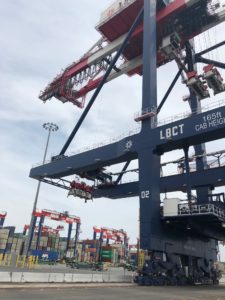
Last week I had the opportunity to tour the world’s first zero-emission marine container terminal at the Port of Long Beach (see photo). The terminal uses fully automated battery electric cargo handling equipment to move containers, with more than 60 lead acid battery electric units running in every day service.
Here is a video I took of the autonomous vehicles, which are pretty mesmerizing to see move on their own:
[youtube https://www.youtube.com/watch?v=z-rJJiKNtLM&w=560&h=315]
The entire project cost well over $1 billion to build and took years to secure all the permitting, according to port officials who led us on the tour. Despite the productivity gains, port leaders seem unlikely to expand the use of the technology anytime soon, given funding constraints.
Still, the terminal is not without controversy. As I blogged about previously, the project led to a battle between labor unions and port officials, as the automations component led to longshoremen layoffs.
Ultimately, as port officials, policy makers, and advocates move toward cleaner freight at the ports, issues such as automation and workforce participation will play a major role in determining the technologies and implementation going forward.
It’s a topic we’ll discuss at the upcoming free UCLA/Berkeley Law conference on June 8th at UCLA on zero-emission freight at Southern California’s ports, featuring a keynote presentation by California Air Resources Board chair Mary Nichols. Sign up today to learn more about this and other issues related to sustainable freight at the ports. MCLE credit available for attorneys. Space is limited!
One thought on “Touring World’s First Automated, Zero-Emission Port Terminal”
-
Pingback: The Future Of Zero-Emission, Automated Ports Is Already Here | Ethan Elkind
Comments are closed.


